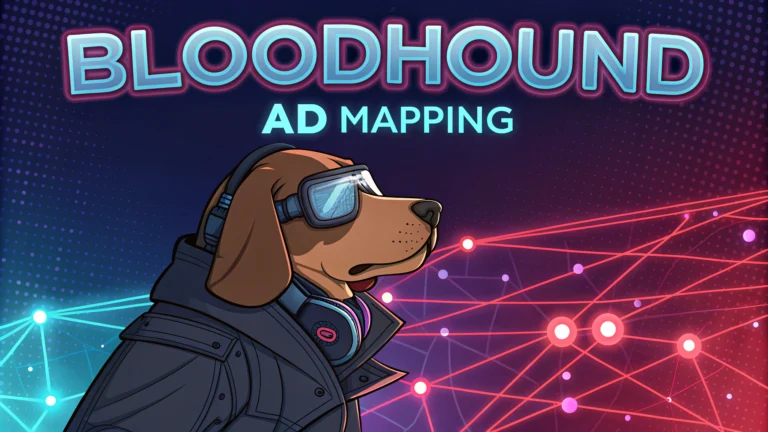BloodHound is a powerful Active Directory (AD) reconnaissance tool that maps relationships and attack paths within Windows domain environments.
This quick guide shows how to use BloodHound effectively and safely during penetration testing engagements.
What BloodHound Does
BloodHound collects and visualizes Active Directory data to reveal hidden and unintended relationships that attackers could exploit.
- Maps AD objects and relationships
- Identifies privilege escalation paths
- Shows shortest paths to high-value targets
- Reveals nested group memberships
- Detects misconfigurations and security risks
Installation Steps
- Install Java Runtime Environment (JRE)
- Download Neo4j database
- Install BloodHound from GitHub
- Set up SharpHound ingestor
Running BloodHound
Start data collection using SharpHound with this command:
.SharpHound.exe -c All --OutputDirectory "C:BloodHound"Key Features to Use
- Pre-Built Queries – Quick analysis of common attack paths
- Custom Cypher Queries – Advanced search capabilities
- Graph Visualization – Interactive relationship mapping
- Path Finding – Shortest route to privileged accounts
Safety Considerations
- Get written permission before scanning
- Use during approved testing windows
- Secure collected data properly
- Delete data after testing
Useful Resources
Report findings responsibly and work with system administrators to fix identified issues.
Contact the BloodHound team through their Discord channel for technical support.
Advanced Analysis
Effective Query Writing
Cypher queries allow deep investigation of Active Directory relationships. Common queries include:
MATCH p=(n:User)-[r:MemberOf*1..]->(g:Group) RETURN p
MATCH p=shortestPath((n:User)-[*1..]->(m {highvalue:true})) RETURN pData Interpretation
- Node colors indicate object types
- Edge types show relationship categories
- Line thickness represents access strength
- Icons highlight high-value targets
Remediation Strategies
Address discovered vulnerabilities through:
- Removing unnecessary group memberships
- Implementing least-privilege access
- Breaking circular trust relationships
- Securing service accounts
Reporting Best Practices
- Document attack paths clearly
- Provide actionable mitigation steps
- Include visual relationship maps
- Prioritize critical findings
Conclusion
BloodHound transforms Active Directory security assessment by revealing complex attack paths and relationships. Effective use requires:
- Proper authorization and scope definition
- Careful data handling and analysis
- Clear communication of findings
- Responsible disclosure practices
Regular BloodHound assessments help maintain robust Active Directory security posture and prevent potential attacks through discovered paths.
FAQs
- What is BloodHound and how does it work in Active Directory environments?
BloodHound is an open-source tool that uses graph theory to reveal hidden and potential attack paths in Active Directory environments. It collects data using SharpHound (C#) or BloodHound.py (Python) collectors and visualizes relationships between AD objects. - What types of attack paths can BloodHound discover?
BloodHound identifies paths involving domain admin rights, nested group memberships, kerberoastable accounts, DCSync rights, PowerShell session access, and other Active Directory privilege escalation vectors. - How does BloodHound collect Active Directory data?
BloodHound uses collectors (SharpHound or BloodHound.py) to gather information through LDAP queries, API calls, and network requests, collecting data about users, computers, groups, ACLs, sessions, and trusts. - What are the main components needed to run BloodHound?
BloodHound requires Neo4j graph database for data storage, a data collector (SharpHound or BloodHound.py), and the BloodHound GUI interface for visualization and analysis. - How can organizations defend against BloodHound reconnaissance?
Organizations can implement network segmentation, limit privileged access, regularly audit AD permissions, monitor for suspicious LDAP queries, and implement proper ACL management to minimize attack paths. - What are the key differences between SharpHound and BloodHound.py collectors?
SharpHound is written in C# and runs on Windows systems with better AD integration, while BloodHound.py is Python-based, runs on multiple platforms, and is less likely to trigger Windows security alerts. - Can BloodHound operate without domain credentials?
While BloodHound requires some level of domain access to collect data, it can operate with basic domain user credentials. However, higher-privileged accounts will reveal more information about the AD environment. - What types of relationships does BloodHound map in Active Directory?
BloodHound maps relationships including MemberOf, HasSession, AdminTo, CanRDP, ExecuteDCOM, AllowedToDelegate, TrustedBy, and various Active Directory permission assignments. - How does BloodHound help in post-exploitation scenarios?
BloodHound helps identify the shortest path to high-value targets, reveals privilege escalation opportunities, and shows potential lateral movement paths that might not be obvious through traditional enumeration. - What file formats does BloodHound use for data storage and transfer?
BloodHound collectors generate JSON files containing the AD data, which are then imported into the Neo4j database. The GUI reads from Neo4j for visualization and analysis.








